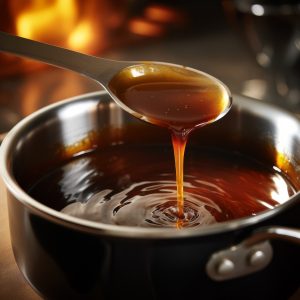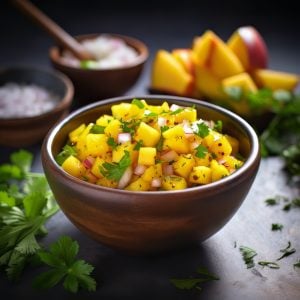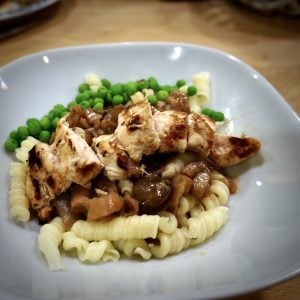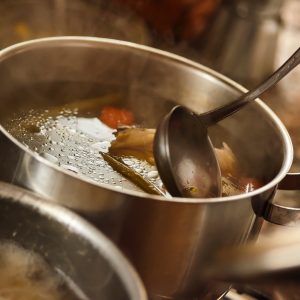Cooking with Hot Peppers
Cooking with hot peppers can add a bold and spicy kick to any dish, but it is important to handle them with care. You especially have to be careful when making this habanero sauce recipe. It is extremely hot.
Here are some tips for cooking with hot peppers:
- Wear gloves: Hot peppers contain capsaicin, which is the compound that gives them their heat. Capsaicin can cause a burning sensation on the skin, and it is difficult to wash off. To avoid getting capsaicin on your skin, it is a good idea to wear gloves while handling hot peppers.
- Cut carefully: When cutting hot peppers, be sure to use a sharp knife and cut them on a cutting board. Avoid touching your eyes or face while cutting the peppers, as the capsaicin can cause irritation. If you do accidentally touch your eyes or face, wash the affected area with soap and water.
- Adjust the heat to your taste: The heat level of hot peppers can vary greatly, even within the same variety. To adjust the heat level of a dish, you can either use more or less hot peppers, or remove the seeds and ribs, which are the parts of the pepper that contain the most capsaicin.
- Balance the heat with other flavors: To balance the heat of hot peppers, try pairing them with ingredients that can help to tame the heat. For example, creamy or acidic ingredients, such as sour cream or lime juice, can help to cool down the heat of hot peppers.
- Keep in mind the heat level of different hot pepper varieties: There are many different varieties of hot peppers, and they can vary greatly in heat level. Some of the most common hot pepper varieties include jalapenos, serranos, habaneros, and Scotch bonnets. Jalapenos and serranos are generally considered to be medium-hot, while habaneros and Scotch bonnets are much hotter. If you are not used to cooking with hot peppers, it is a good idea to start with a milder variety and work your way up to hotter peppers as you become more comfortable with them.
Cooking with hot peppers can add a unique and flavorful kick to any dish, but it is important to handle them with care and adjust the heat level to your personal taste. With a little practice, you will be able to create delicious and spicy dishes that are sure to impress your friends and family.
What Is the Scoville Scale?
The Scoville Scale is a measure of the spicy heat of a pepper, as determined by the concentration of capsaicinoids, the compounds that give peppers their heat. The scale was named after its creator, American pharmacist Wilbur Scoville, who developed the method in 1912.
The scale ranges from 0 to over 3 million Scoville heat units (SHUs). Here is a rough guide to the heat levels of some common peppers:
- Bell peppers: 0 SHUs
- Poblano peppers: 1,000-2,000 SHUs
- Jalapeno peppers: 2,500-8,000 SHUs
- Serrano peppers: 10,000-23,000 SHUs
- Habanero peppers: 100,000-350,000 SHUs
- Ghost peppers (bhut jolokia): 800,000-1,000,000 SHUs
- Carolina Reaper: over 2,200,000 SHUs
Please note that these are rough estimates, and the actual heat level of a pepper can vary depending on factors such as the specific variety, growing conditions, and measurement method. In general, the smaller and thinner the pepper, the hotter it tends to be.
The Scoville Scale is a valuable tool for determining the relative heat of different peppers; however, it is essential to remember that everyone’s tolerance for spicy heat varies. Some people may find a jalapeno pepper to be too hot, while others may consider it mild. The best way to gauge your tolerance for spicy heat is to try different peppers and see how you react to them.
Habanero Peppers

Habanero Sauce
Ingredients
- 10 habanero peppers
- 1 cup vinegar
- ½ cup water
- 2 cloves garlic minced
- 1 teaspoon salt
- 1 teaspoon sugar
Instructions
- Remove the stems and seeds from the habanero peppers. Wear gloves to protect your hands from the capsaicin, the compound that gives peppers their heat.
- Place the peppers in a blender or food processor with the vinegar, water, garlic, salt, and sugar.
- Blend the mixture until it is smooth.
- Pour the sauce into a small saucepan and bring it to a boil over medium heat.
- Reduce the heat to low and simmer the sauce for 10-15 minutes, or until it has thickened slightly.
- Allow the sauce to cool, then transfer it to a jar or bottle. Store the sauce in the refrigerator for up to 3 months.














6 Responses
Habaneros aren’t even close to “hottest pepper on earth”.
JB, if not the hottest, they are right up there. The black habanero is 400,000 to 450,000 on the Scoville scale and according to Wikipedia, ‘A “Caribbean Red” is a variant within the habanero family with a Scoville rating of 500,000 units.’
If there are hotter JB, I would appreciate you letting me know which ones are and how hot they are so I can be sure to stay away from them. Thanks.
Two most well-known super hot peppers; Ghost pepper (~1 million Scoville) and Trinidad Scorpion (~2 million Scoville). There’s a handful of others that are hotter than habaneros but less than ghost peppers.
Naga Morich, Dorset Naga, Naga Viper, Carolina Reaper etc etc
According to Guinness World Records, “The hottest chilli is Smokin Ed’s ‘Carolina Reaper’, grown by The PuckerButt Pepper Company (USA), which rates at an average of 1,569,300 Scoville Heat Units (SHU), according to tests conducted by Winthrop University in South Carolina, USA, throughout 2012.”
The question is where are you going to get your hands on this or any of the peppers you mention. If you go into most supermarkets these days, you’re likely to find habanero peppers but good luck finding any of these others but thank you for bringing them to my attention.
Blair’s 5 a.m. is rated at 5,500,000.
I use it in my homemade sauce. bill